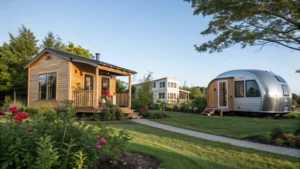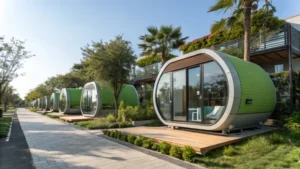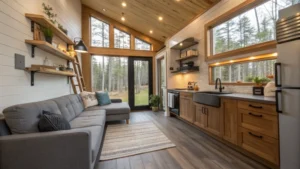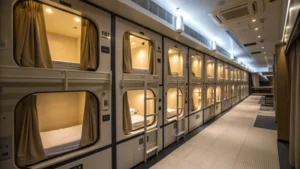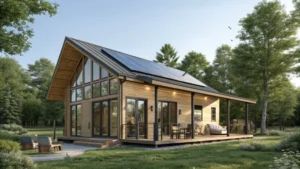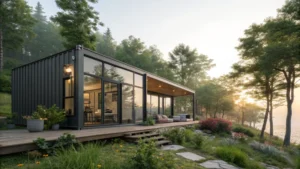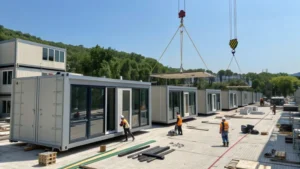%[A modern prefabricated house with large glass windows in a green landscape](https://cozehouse.com/wp-content/uploads/2024/12/modern-prefabricated-house-in-green-landscape.webp "Modern Prefabricated House")
Thinking of going prefab for your next home? Join me on a journey through the pros and cons of this modern housing solution.
**Prefab houses offer cost savings and speedy construction due to streamlined manufacturing and reduced labor expenses. However, they can encounter zoning hurdles and increased transportation costs.**
I remember the first time I stumbled upon the concept of prefabricated homes. It was like discovering a hidden gem in the world of housing—cost-effective, quick to build, and customizable. But like any good thing, they come with their own set of challenges. Whether you're a potential homeowner or a developer, understanding the intricacies of prefab houses is crucial. Let's dive deeper into what makes them appealing and the hurdles you might face along the way.
Prefab houses are more expensive than traditional homes.False
Prefab houses are generally more cost-effective due to lower labor costs.
Zoning laws can restrict where prefab homes are built.True
Certain areas have zoning restrictions that limit prefab home construction.
## How Do Prefab Homes Compare to Traditional Construction?
Ever stood at a crossroads, wondering if prefab or traditional construction is the right path for your dream home? The differences might just surprise you.
**Prefab homes offer speedy builds, budget-friendly prices, and green designs, while traditional homes provide unmatched design freedom and tried-and-true methods. Weigh local rules, design desires, and long-term visions to decide.**
%[A modern prefab home next to a traditional brick house in a sunny neighborhood.](https://cozehouse.com/wp-content/uploads/2024/12/modern-prefab-home-traditional-house.webp "Modern vs Traditional Homes")
### Speed and Efficiency
**Prefabricated Homes:** When I first started exploring prefab homes, the idea of rapid construction was like discovering a magic trick. Prefabricated homes, built in pieces in a factory, are like a giant LEGO set waiting to be assembled on-site. This drastically cuts down on construction time. Imagine being able to move into your new home weeks, or even months, earlier than with a traditional build—especially crucial when time is of the essence, like in [disaster relief situations](https://www.triumphmodular.com/blog/how-modular-construction-is-used-for-disaster-relief/)[^hdphcttc-1].
**Traditional Construction:** On the flip side, traditional construction can feel like watching paint dry. Weather delays and the coordination of various tradespeople often extend the building timeline significantly. This was a big factor for me when I considered how long I could handle living in a temporary setup.
### Cost Considerations
| Aspect | Prefabricated Homes | Traditional Homes |
|-----------------------|---------------------|------------------|
| Initial Costs | Lower | Higher |
| Labor Costs | Reduced | Variable |
| Customization Costs | Potentially Higher | Varies |
For someone like me, who loves a good deal, the lower initial costs of prefab homes were very appealing. Thanks to efficient manufacturing processes and reduced labor expenses, these homes often come at a friendlier price point. However, if you're dreaming of intricate customizations, be aware that those costs can climb.
Traditional homes may hit you with higher labor costs upfront but offer greater design flexibility. I remember chatting with a friend who said her home was like a blank canvas—she could tweak every detail to her heart’s content.
### Customization and Design Flexibility
**Prefabricated Homes:** With prefabricated homes, you have a good level of customization, yet you might bump into some limitations due to manufacturing capabilities. But hey, they're getting more creative, particularly in eco-friendly resort designs!
**Traditional Construction:** Traditional construction is the playground for design enthusiasts. Want an octagon-shaped room or a secret passageway? The sky's the limit here! It's all about implementing those unique touches that make a house truly your own.
### Quality and Sustainability
Prefab homes are crafted in controlled environments, ensuring precision and minimal waste—a big win if sustainability is close to your heart like it is for me. This aligns perfectly with modern eco-conscious trends.
Conversely, the quality of traditional homes often relies heavily on the skill level of local contractors and available materials. This variability can sometimes be nerve-wracking unless you have trusted experts on your team.
### Regulatory and Zoning Challenges
**Prefabricated Homes:** In my journey through zoning regulations, I found that prefabricated homes can face hurdles, especially in areas not yet familiar with this method of construction. These regulatory hoops can slow projects down and add unexpected costs.
**Traditional Construction:** Traditional homes usually glide through existing local regulations more smoothly since they are built using established methods. However, specific design restrictions may still apply depending on your location.
Ultimately, choosing between prefab and traditional homes boils down to your priorities—be it budget, timeline, design flexibility or sustainability. Each has its perks and challenges that align differently with individual needs and goals. I found that developers who prioritize [sustainable solutions](https://elemental.green/18-inexpensive-sustainable-homes-almost-anyone-can-afford/)[^hdphcttc-2] often lean towards prefab options for their eco-friendly edge. Meanwhile, those seeking one-of-a-kind architectural features may find the freedom they crave in traditional builds.
Prefab homes have faster construction times than traditional homes.True
Prefab homes are built in factories and assembled quickly on-site.
Traditional homes always cost less than prefab homes.False
Prefab homes often have lower initial costs due to efficient processes.
[^hdphcttc-1]: Learn how prefab homes offer quick deployment solutions crucial during emergencies.
[^hdphcttc-2]: Discover sustainable practices integrated into modern prefab home designs.
## What Are the Financial Implications of Choosing a Prefab House?
Ever wondered if a prefab home could be your ticket to financial freedom and smart living?
**Prefab houses generally offer cost savings through efficient production and faster assembly but can incur additional costs like transportation and financing challenges, affecting overall affordability and investment value.**
%[A modern prefab house in a serene suburban setting](https://cozehouse.com/wp-content/uploads/2024/12/modern-prefab-house-suburban-environment.webp "Modern Prefab House")
### Lower Initial Costs
When I first considered the world of prefab housing, the potential savings were immediately appealing. These homes come with lower initial costs thanks to their streamlined manufacturing processes, which really appealed to my budget-conscious side. Imagine a factory churning out homes like clockwork, reducing labor expenses and minimizing wasted materials. This efficiency translates into tangible savings—savings I could reinvest into other important aspects of life.
| Cost Aspect | Prefab Homes | Traditional Homes |
|--------------------|--------------------|--------------------|
| Labor Costs | Lower | Higher |
| Material Costs | Lower (bulk buying)| Varies |
| Construction Time | Shorter | Longer |
### Transportation and Logistics
However, the journey doesn't end at production. I quickly learned that getting these prefab modules to my desired location wasn't as straightforward as I'd hoped. Transporting them, especially to a remote site, can be a logistical challenge—and not a cheap one at that. Each module requires careful handling, sometimes involving specialized equipment, which can inflate the overall cost. It was like planning a road trip where every bump or detour could impact my budget.
### Financing Challenges
Another hurdle I faced was financing. Many [financial institutions](https://www.nextmodular.com/finance-modular-home/)[^watfiocaph-1] view prefab homes as unconventional investments, which can complicate securing loans. This perception might mean higher interest rates or tougher loan conditions. It's like the financial equivalent of trying to convince your bank that your unconventional vacation plans are worth the splurge—except this time, it's your home.
### Long-term Value Considerations
As I dug deeper, the question of long-term value loomed large. Would my prefab home appreciate like a traditional house? While many prefab homes are built to last, their resale value can vary significantly.
| Factor | Impact on Value |
|--------------------|--------------------|
| Design Constraints | Potentially Negative|
| Market Perception | Varies |
| Build Quality | Positive |
Factors like design constraints or local market perceptions can sway potential buyers. It’s similar to investing in a classic car—some models appreciate over time, while others don’t capture the same interest.
### Customization vs. Cost
The allure of customizing my home was strong—being able to tailor it just so was incredibly tempting. But I had to balance this with the reality that extensive customization could spike the costs, offsetting the initial savings. It's much like going into an ice cream shop: you want all the toppings, but each scoop and sprinkle adds up.
Understanding these financial aspects helped me weigh whether a prefab home aligned with my financial goals and lifestyle aspirations. Considering factors like transportation logistics, [financing options](https://www.livemodal.com/blog/do-modular-homes-hold-their-value-0)[^watfiocaph-2], and long-term value helped me make a more informed decision about this modern housing alternative.
Prefab homes have lower initial costs than traditional homes.True
Efficient manufacturing and economies of scale reduce labor and material costs.
Financing prefab homes is easier than traditional homes.False
Financial institutions often see prefab homes as higher-risk, complicating financing.
[^watfiocaph-1]: Learn about the financing challenges and solutions for securing loans for prefabricated homes.
[^watfiocaph-2]: Understand how the resale value of prefab homes compares to traditional constructions.
## Can Prefab Houses Truly Support Sustainable Living?
Ever wondered if those sleek, modern prefab homes can truly support a sustainable lifestyle? Let's explore how these innovative designs stack up against traditional eco-friendly housing.
**Yes, prefab houses can meet sustainable living standards. By using eco-friendly materials, energy-efficient designs, and reducing waste through controlled manufacturing processes, they align well with sustainability goals. Their adaptability and scalability further enhance their eco-credentials.**
%[A modern prefabricated house surrounded by greenery and solar panels](https://cozehouse.com/wp-content/uploads/2024/12/modern-prefabricated-house-eco-friendly.webp "Modern Prefabricated House")
### Integrating Eco-Friendly Materials
I remember the first time I walked into a prefab house that used [sustainable wood](https://elemental.green/18-inexpensive-sustainable-homes-almost-anyone-can-afford/)[^cphtssl-1] and recycled steel—it was like stepping into the future. These houses are crafted with care, often incorporating non-toxic insulation to keep things green. It's all about minimizing the environmental impact during production, which makes these homes a guilt-free choice for eco-conscious folks like us.
### Energy-Efficient Designs
Imagine having a home that’s practically smarter than you are! Prefab homes often come equipped with solar panels, high-efficiency windows, and LED lighting. It’s like having a little eco-warrior sitting on your roof, helping you cut down on energy consumption. Some of these homes even boast smart technology that optimizes energy usage all day long. How cool is that?
| Feature | Benefit |
|-----------------------|------------------------------------|
| Solar Panels | Reduces reliance on fossil fuels |
| High-Efficiency Windows| Enhances thermal regulation |
| LED Lighting | Lowers energy consumption |
### Reducing Waste Through Controlled Manufacturing
The beauty of prefab construction lies in its precision. Building homes in a factory-controlled environment means less waste and more efficiency. Traditional construction often leaves behind a trail of excess materials, but with prefab, it’s all about making the most out of every piece.
### Adaptability and Scalability
Prefab homes are like adult Lego sets—they can be expanded or modified as needed without tearing everything down. This makes them perfect for urban developments focused on sustainability or for anyone who needs a home that grows with them.
### Challenges to Consider
However, it's not all sunshine and rainbows. Zoning restrictions can be a real headache, as I’ve learned through some frustrating delays. Transportation costs to remote areas can also add up quickly. Financing can be tricky too, with some banks viewing these homes as less stable investments compared to traditional builds.
[Learn more about overcoming zoning challenges](https://modularhomesource.com/affordable-housing-challenges-and-solutions-inclusionary-zoning-and-offsite-construction/)[^cphtssl-2] in prefabricated housing projects. Despite these hurdles, the potential for prefab houses to support sustainable living is huge. With technology advancing and policies evolving, the alignment with eco-friendly standards will only get better.
Prefab houses use recycled steel for construction.True
Prefab houses often incorporate recycled steel to minimize environmental impact.
Prefab homes cannot incorporate smart home technologies.False
Many prefab homes are equipped with smart technologies for energy efficiency.
[^cphtssl-1]: Explore the benefits of using sustainable wood in prefab houses, including environmental impact reduction and renewable resource advantages.
[^cphtssl-2]: Discover strategies to navigate zoning laws and successfully implement prefab housing projects.
## What Are Common Misconceptions About Prefab Homes?
I remember my first encounter with a prefab home—it was love at first sight! Yet, I was surprised by how many misconceptions surrounded these innovative homes.
**Common misconceptions about prefab homes include beliefs that they are low quality, lack customization, and are not environmentally friendly. However, prefab homes can be highly customizable, sustainably built, and offer high-quality construction.**
%[Modern interior of a prefab home with open floor plan](https://cozehouse.com/wp-content/uploads/2024/12/modern-prefab-home-interior.webp "Modern Prefab Home Interior")
### Misconception 1: Prefab Homes Are Low Quality
When I first learned about [prefab homes](https://www.buildwithrise.com/stories/is-prefab-better-than-traditional-building)[^wacmaph-1], I too was skeptical about their quality. It reminded me of the time when I bought my first smartphone, and everyone doubted its capabilities because it wasn't a mainstream brand. Much like that phone surprised everyone with its durability and features, modern prefab homes break the stereotype of being flimsy. They're built in state-of-the-art facilities using high-quality materials, ensuring each piece fits perfectly. Imagine baking cookies in a temperature-controlled oven versus one that's all over the place—precision makes all the difference!
### Misconception 2: Limited Customization Options
I'll never forget the look on my friend's face when they saw my newly installed solar panels on my [modular home](https://avenueofhomes.net/how-to-build-a-custom-modular-home/)[^wacmaph-2]. "Wait, you can do that with a prefab?" they asked. Yes, indeed! Prefab homes offer incredible customization options. You can choose layouts, finishes, and even sustainable features like solar panels or rainwater systems. It's like picking toppings for your pizza—you get exactly what you want, all while making eco-friendly choices.
### Misconception 3: Prefab Homes Aren't Environmentally Friendly
A few years back, I was searching for ways to reduce my carbon footprint. That's when I discovered how prefab homes integrate eco-friendly practices. These homes are designed to minimize waste with precise material calculations and often include [sustainable technologies](https://preferredhomesmi.com/modular/eco-friendly-modular-homes/)[^wacmaph-3] like energy-efficient appliances. It's akin to swapping out plastic bags for reusable ones—small changes that collectively make a big impact.
| Misconception | Reality |
|---------------|---------|
| Low Quality | High precision and quality control |
| Limited Customization | Wide range of design options |
| Not Eco-Friendly | Sustainable building practices |
Understanding these realities has not only helped me appreciate prefab homes more but also made me realize their true value. They're an innovative housing solution that breaks away from traditional myths, much like how we once doubted smartphones would ever replace our trusty landlines.
Prefab homes are built with low-quality materials.False
Modern prefab homes use high-quality materials for durability.
Prefab homes offer limited customization options.False
Prefab homes provide various customizable features and layouts.
[^wacmaph-1]: Explore how modern prefab homes meet and often exceed traditional housing standards in durability and quality.
[^wacmaph-2]: Discover the customization options available for modular homes, including design flexibility and sustainable features.
[^wacmaph-3]: Learn about the sustainable technologies and practices used in prefab home construction that reduce environmental impact.
## Conclusion
Prefab houses provide cost savings, quick construction, and eco-friendly options but face zoning challenges and potential financing issues. Understanding these factors is crucial for prospective homeowners or developers.



